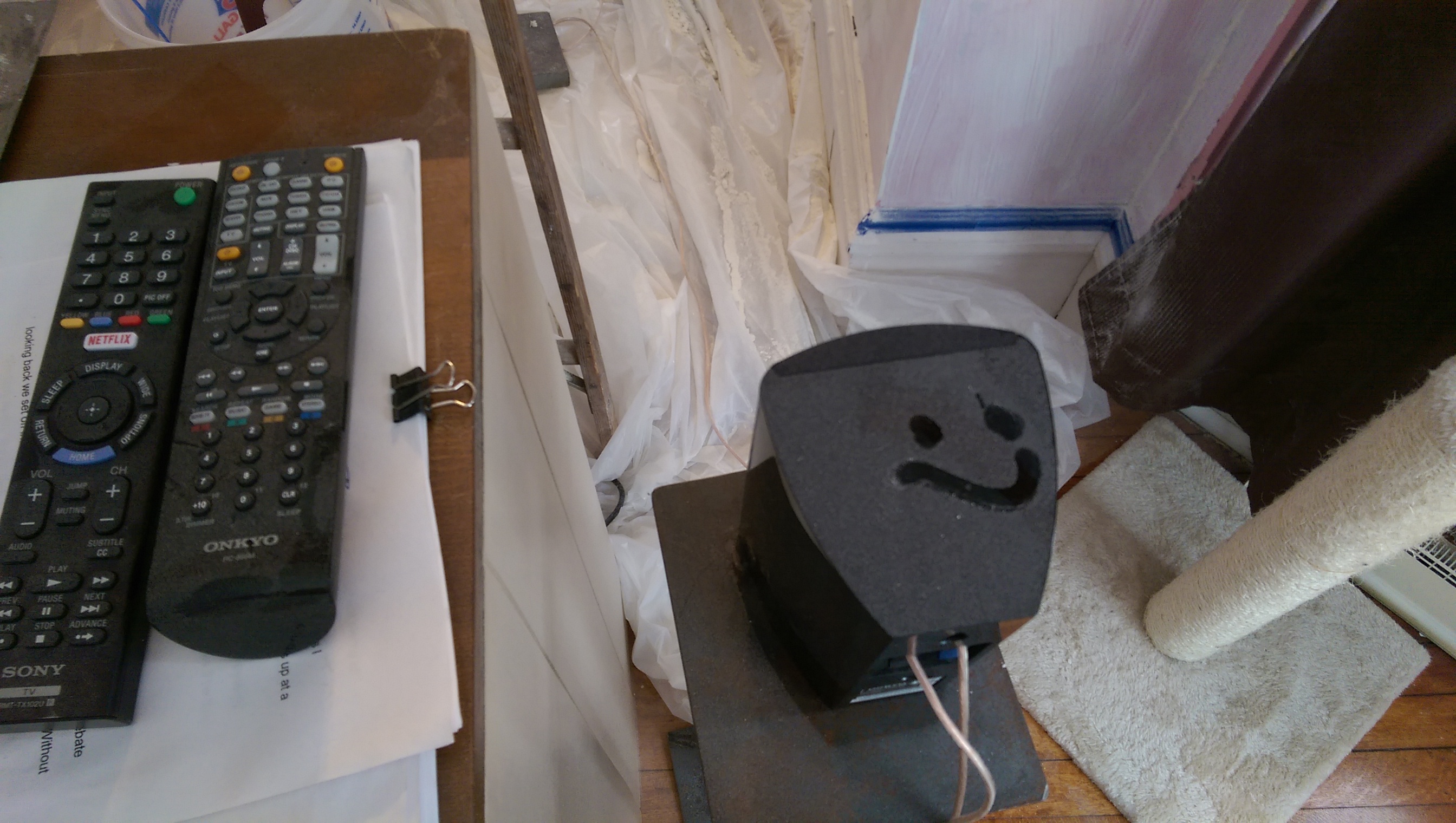Welcome! In this installations of ‘stuff what I done’ we’ll be going over my first attempts at fixing holes and cracks in plaster. I’m going to start with the living room here since that’s the room my last post focused on.
Shortly before Christmas of last year I reached out to a former co-worker who has a lot of experience working on houses. We’d previously discussed some of the plaster cracks and other work I needed to do when we worked together and she let me know she’d be willing to help. So I got in touch with her and she came over to help me figure out what the heck I was supposed to be doing (she also gave us a giant tub of patching plaster to get started with). Ali went around and marked the spots that were large enough to bother us and then we got started.
The largest patch I’ve done to date is on the wall with water damage that I mentioned in my last post. There was a good foot wide swath that was set in differently from the surrounding wall, possibly from a patch panel that would have been put in prior to the wallpaper. This was a bit tricky since it was such a wide patch and getting it to stay even while working such a large area was difficult. Luckily Diane had brought a few of her tools and one of them was a 6″ blade to smooth with. We filled the cracks, taped over them, and then focused on filling in the area that was a different depth than the surrounding wall.





After a ton of sanding, which I’ll get into later in a “lessons learned” sort of section, we were ready for another layer. After that, I sanded again and put down one more big layer before moving to finishing layers. Basically that meant paying a little more attention to how I was spreading the plaster and making sure any low spots where brought level. You also want to make sure the transition between original wall and patch are smooth, in the picture below you can seen how jarring the edges would be if I didn’t smooth those out.



It turned out much better than I expected for such a large patch. There are definitely some small areas where you can tell it’s not completely kosher and when you look at the (now painted) area on the wall there is an “uncanny valley” sort of thing going on if you stare at it too long. I suspect that has more to do with the slightly different texture of the plaster versus the wall that was already there.
The next order of business was the water damaged trim above the large patch. This was more difficult than most other patches due to it’s curves and corners.




In the last picture you can see we were entertaining the idea of using some tape to help cover the corners and make the finish look smoother. Unfortunately the curve wasn’t having it. We did eventually get a good bit of the first few layers smoothed out but the corner was still giving us trouble. In the end, there was nothing we could do but be very gentle and patient with how we patched and sanded the curves and corners. After a lot of attention and care, it turned out really well.






We also had a nice hole near some of the trim for one of our pocket doors. Diane brought a stick-on metal matrix that helps make these sorts of patches easier.



That hole patching kit worked well, but I tried another in a different area that didn’t work so well for me. Ultimately, I found it’s more reliable for me to just fill further holes full of the base compound I use. The benefit of not using the kit is that you don’t have to smooth over the slight bulge that the metal or fabric matrix will create, but it does take longer to fill. Go with whatever works for you.
So what did I learn?
I learned how to patch corners, both outside corners and inside corners! We had some corners that had an odd, almost caulk like filler in them so I took that out and put in plaster as it takes paint better and should also age much better.

I learned a few other lessons along the way as well, and I’ve continued to learn as I patch more and more of our old plaster.
Lesson the first: prep the area the right way. This means scraping away any bubbled paint (which we had on the water damaged parts), scraping off any loose paint around cracks, pulling out any previously applied and now cracked plaster inside said cracks, and getting rid of anything else that will make it a pain to get a good finish.
Lesson the second: it’s much faster to do some heavy layers when you start out and then do more detailed work as you get closer to the finish stage. This is especially true the larger or deeper the crack is. I started out doing a lot of small layers when I did my first few patches, but on larger patch jobs that adds up. Don’t be afraid to lay down a heavy layer, it will take longer for it to dry out so you get a bit more time to tidy up before it becomes unworkable. For the deep crack below I did 3 heavy layers to fill most of the hole while keeping the surface area clean and then moved to finishing plaster to fill the remainder of the crack and blend it into the surrounding wall. I did probably 3 layers with the finishing stuff to get it nice and even.



It’s best to keep the patch as level as possible when doing the initial heavy layers as it will save you time later when you’re finishing the patch up. Keeping the entire area clean when you apply each layer also helps mitigate some of lesson 3.
Lesson the third: sanding sucks, do as little as possible. The dust will get everywhere so grab your respirator and some goggles and don’t wear any nice clothing. Try to do all the sanding at one time and put something down, this will save you from having to clean too much and having to re-dust everything any time you sand.
I’d also recommend getting a little $30 DeWalt Mouse sander or something of the sort. Diane let me use hers for a week and it makes quick work of knocking down any imperfections. For the final sanding and touch ups I do prefer a sanding block, I picked up a few different grits at our local Ace and they work well. However, doing large patches or even multiple small patches gets old quick with sanding blocks.



Lesson the fourth: Use the right plaster for the job. There are finishing plasters that are lighter and easier to sand and there are base plasters that harden up real nice to take care of cracks but are harder to work with and sand once dry. Guess which one I started with? Yeah, sanding is already bad but it’s worse when you’re trying to sand what is essentially concrete.
Lesson the fifth: pay attention to the borders of your patch. You want to make sure you blend the area you’ve patched into the surrounding wall so that it won’t be easily noticeable once it’s painted. I didn’t do this very well in some spots and now every time I see those I think about sanding them down and repainting. I don’t because I’m lazy. It’s also important to note the texture of the wall near the patch, some of our walls have more texture than others so my patches naturally stand out due to the change in texture. Unless you want to use or make textured paint to hide it, I’m not sure what you can really do about that.
Bring all of this together and you’ve got a good start to patching with plaster. Over time you’ll notice how different brands react to your style of work and find the best fit for you. I personally prefer DAP Patching Plaster as my base, it hardens up really well and is best for filling cracks or holes. Then I move to DAP Wallboard Joint Compound to do my leveling, it makes for a very workable finish and smells nice. As a bonus it also takes paint better than the brand I used in our living room so patches are less visible in other areas of our home.


So there you have it. Patching with plaster is pretty easy, you just have to take your time learning and be willing to experiment with different brands and styles of work. With all of that out of the way here are some other random things that happened around the same time!


We got two Japanese Quail (coturnix quail if you’re fancy) that made Sophie pretty excited when we brought them home. Sophie doesn’t live with us anymore due to some incompatibility with our water. My parents took care of the birds and our cats while Ali and I were on our honeymoon and Sophie was quite happy to see them again.
Winter also brought our first indication that we have quite a few squirrels in our area. Yay.


